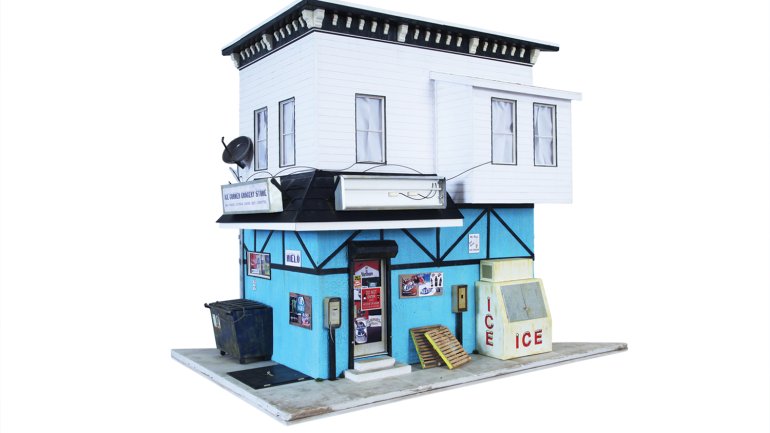Ode to the Corner Store
Ode to the Corner Store
“Artists were originally drawn to the Fishtown neighborhood because it was cheap to buy and rent houses there. But these days, you just can’t find an affordable place,” says sculptor Drew Leshko, 34.
He knows what he’s talking about: The artist and his wife bought a home in the Philadelphia neighborhood in 2007. Because the area’s housing was still affordable, they also could rent convenient workshop space across the street.
Fast-forward to 2016: The workshop owner put the property on the market, forcing Leshko to move out. Rents were skyrocketing, and the artist found himself priced out of studio space in his own neighborhood.
His plight added a personal dimension to his work memorializing the quickly changing urban landscape around him: He re-creates structures in their transitional states as they await the contractor or the bulldozer.
The artist, who earned a degree in communications and fine art from West Chester University in 2005, starts by taking photographs of sites that interest him, then rebuilds them in his studio. Using the photos as a reference, he works with Strathmore papers and illustration board, which he prefers because of its structural soundness. Then he cuts out individual components with a razor blade, creating the 3D façades with layering and inlay, assembling and painting everything to match the original structures. “But I won’t give away all of my secrets,” he says, laughing.
Leshko works at “dollhouse scale” (1:12). At that size, he can make everything look detailed, authentic, and recognizable, while retaining enough creative freedom to allude to less prominent aspects by simplifying them. “One foot in real life equals 1 inch in my work,” he explains. “It’s a nice scale to work with because it makes my math easy and consistent.” He’s quick, however, to note that his work is sculpture, not “models,” a word he associates with kits and prefabricated assemblage. “Clearly not how I work,” he says.
Like a photographer who documents a specific moment in time, the artist wants to spotlight the many incongruous building repairs he regularly observes, the jarringly primitive solutions and quick fixes. He cites one building as an example. “Upstairs, on the outside, you can see the most wonderful cornices, but downstairs you will find the wildest-looking bodegas, convoluted with all kinds of building materials and objects.”
The 1860 Ampere Electric building around the corner from his house, which Leshko re-created in 2013, has had a storied history few outside the neighborhood know about. Originally built as a firehouse, at various points it also housed a vaudeville theater, a brothel, a veterans’ hall, and a post office. The current inhabitant is a motor repair shop. “Apparently, the tile work inside is amazing and [has been] kept to some degree,” Leshko says. “But once an owner decides to tear structures like these down to make room for something new, our memories are all that is left of them.”
None of the buildings Leshko wants to preserve are National Register material — and it is exactly that level of unremarkable architecture that interests him. “It is like one of those questions about who or what determines history. Just because it isn’t important to one person does not make it any less important to someone else,” says Leshko.
After he made Spruce Street Market (2015), a woman emailed him. Her father had owned the market in the 1980s, and she had spent much of her childhood roaming the store aisles; growing up, she was known around the neighborhood as the “Spruce Street baby.” She appreciated that someone had recognized a building that meant a lot to her – one that, by all other accounts, would be deemed rather unremarkable. “You just never really know how people are going to react to an artwork,” Leshko says. “Everyone makes ties in different ways.”
Check out a short video of one of Leshko's pieces with a special guest cameo.




